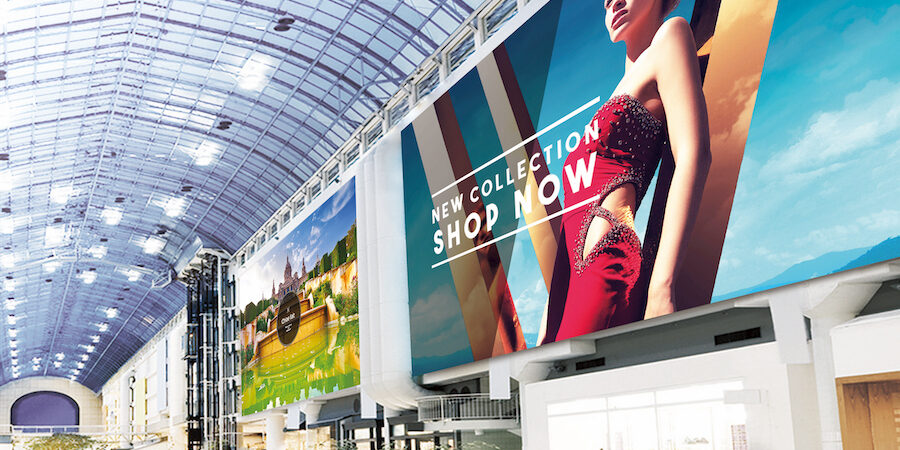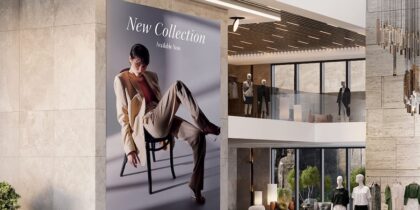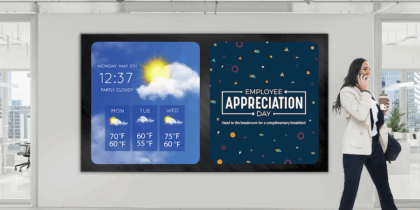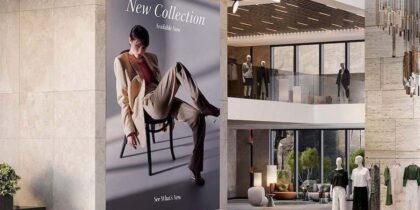There’s one obvious distinction between indoor LED displays and outdoor direct view LED displays: Outdoor displays are engineered to withstand anything nature throws at them. But they also have some less evident distinctions.
Indoor and outdoor LED displays use different core LED technology and feature varying brightness levels, pixel density and overall cost per square foot. But indoor and outdoor displays alike can deliver powerful, full-motion messaging on a huge scale, in unique shapes and ways. The right LED for your needs depends on the installation environment, the viewing distance and the end use for your LED.
What is outdoor LED?
To work reliably for many years, outdoor electronics need to be engineered to handle all sorts of extreme weather conditions, as well as man-made threats from pollution to vandalism.
These outdoor electronics are housed in “cabinets” — units about the size of a suitcase — that are stacked, tiled and connected to create large displays. Those cabinets typically have Ingress Protection (IP) ratings of IP55 or higher to prevent damage from rain, snow, ice and wind-blown dust and pollutants. Engineering also factors in protecting against risks like lightning strikes — particularly with outdoor digital marketing displays mounted on pedestals high above roadways.
How to plan and deploy LED digital signage
Discover the unique advantages of direct-view LED technology over traditional LCD displays. Download Now
Outdoor LED displays often use older technologies such as dual in-line packages (DIP) because of their brightness and rugged design. That’s because outdoor LED displays need to be bright. They may have lumens ratings of 7,000 nits or higher, enough lighting power to enable vivid on-screen visuals even in bright environments like Phoenix and Las Vegas. Outdoor LED displays also have fans and ventilation systems that ensure a long operating life even if temperatures over 100 F bake the displays day after day, for months on end.
Pitches that go the distance
Outdoor displays are almost always viewed from a substantial distance, whether they’re advertising in Times Square or cladding the main facade of a new sports arena. So the individual LED light pixels in outdoor displays can be spaced much farther apart than the pixels in indoor displays.
Using an industry rule of thumb, the optimal audience viewing for a direct view LED display steps back 8 feet per 1 mm of pixel pitch. Most outdoor LED display products start at 8 mm pixel pitch and increase from there, so the optimal viewing distance for a 8 mm (or P8) display is at least 64 feet, because 8 feet by 8 mm equals 64 feet. But from a closer distance, onlookers can see these displays’ individual light pixels and the gaps between them. By comparison, the most popular indoor LED products have a pitch of 3 mm or less.
Outdoor LED cost comparisons and applications
Costs can vary by type and design, but generally, outdoor LED component costs are lower because of the lower-density light pixels. More simply, fewer lightbulbs means lower equipment cost. However, outdoor LED can come with add-on costs less common for indoor LED, like the infrastructure costs to secure display equipment on the side of a building or power a screen along a highway. Outdoor screens also tend to involve much higher paperwork costs for local permits and approvals.
Outdoor LED’s primary early applications were digital out-of-home (DOOH) advertising displays and large-format scoreboards and replay screens in stadiums, but now that the cost of outdoor LED has become more accessible, outdoor LED is seeing widespread adoption in sectors such as gaming and retail. Advertising also has broader applications, with commercial property companies factoring revenue-generating displays into their designs for new developments.
What is indoor LED?
Unlike outdoor LED, the current dominant technology for indoors is Surface Mounted Diodes (SMD) — LED light “packages” that have become progressively smaller than DIP.
Tiny SMD light packages have enabled indoor displays to have pixel pitches as low as 0.8 mm — creating displays that deliver crisp visuals rivaling those of LCD and QLED displays, even from less than 10 feet away.
Emerging technologies like microLED — seen in Samsung’s The Wall series for businesses and homes — use light chips even smaller than those available from SMD. The lights are so tiny that they’re measured in microns, and they can be precision-placed on deep black mounting plates, offering extremely high contrast. Great contrast, using that deep black, is a key measure of any great display.
While indoor LED displays don’t need to be engineered against weather conditions, they have their own operating challenges. Outdoor displays are usually well out of the public’s reach, but indoor displays mounted in stores, arenas and public walkways are at steady risk of suffering bumps, scratches or spills. The tiny SMD light packages are micro-soldered to their modules, making them highly susceptible to damage.
Indoor LED’s varied use cases
Samsung’s The Wall is among the first direct view LED products from a mainstream manufacturer to be designed with a degree of built-in protection — a transparent layer over the light pixels that protects against bumps, resists dusts and water and counteracts electrostatic discharge.
Indoor LED found an early home in sports venues and in advertising applications for big public spaces like airports and rail terminals. But as pixel pitches have grown finer and serviceability has improved (allowing access to the display from the front and reducing space usage), direct view LED has seen widespread adoption, in use cases as varied as flagship retail stores and jaw-dropping feature walls in the lobbies of major offices and public buildings. Direct view LED has made its way into high-end hotel guest suites, hospital lobbies, automotive design centers, command and control centers and many other industries.
Pixel density has also advanced to the point that visuals such as schematics and HD aerial imaging can run behind the scenes in applications like the control rooms and network operations centers of private companies, government agencies and public utilities.
What to use
Sorting out the most suitable LED technology bears similarities to buying a new vehicle. A car or a truck will both get you places, but they’re designed to do different things.
Both outdoor and indoor LED displays can deliver great visuals, but at its core, the technology selection for LED comes down to the installed environment, the application and the viewing distance of the intended audience.
Find the best display for your indoor or outdoor video wall project with this easy selector tool — or read more about your options in this free white paper.









